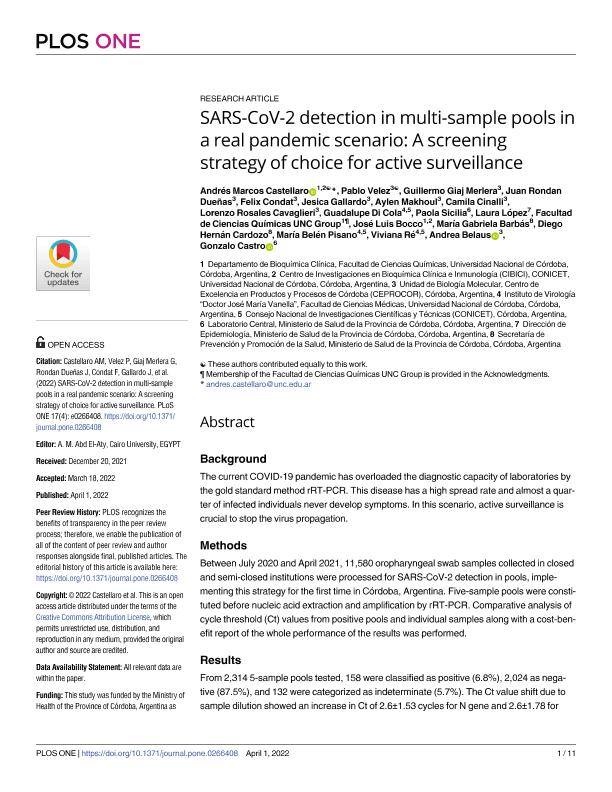Artículo
SARS-CoV-2 detection in multi-sample pools in a real pandemic scenario: A screening strategy of choice for active surveillance
Castellaro, Andrés Marcos ; Vélez, Juan Pablo; Giaj Merlera, Guillermo
; Vélez, Juan Pablo; Giaj Merlera, Guillermo ; Rondan Dueñas, Juan; Condat, Félix
; Rondan Dueñas, Juan; Condat, Félix ; Gallardo, Jesica; Makhoul, Aylén; Cinalli, Camila; Rosales Cavaglieri, Lorenzo Antonio
; Gallardo, Jesica; Makhoul, Aylén; Cinalli, Camila; Rosales Cavaglieri, Lorenzo Antonio ; Di Cola Bucciarelli, Guadalupe
; Di Cola Bucciarelli, Guadalupe ; Sicilia, Paola; López, Laura; Bocco, José Luis; Barbás, María Gabriela; Cardozo, Diego Hernán; Pisano, María Belén
; Sicilia, Paola; López, Laura; Bocco, José Luis; Barbás, María Gabriela; Cardozo, Diego Hernán; Pisano, María Belén ; Ré, Viviana Elizabeth
; Ré, Viviana Elizabeth ; Belaus, Andrea; Castro, Gonzalo Manuel
; Belaus, Andrea; Castro, Gonzalo Manuel ; Crespo, Pilar María
; Crespo, Pilar María ; Furlán, Gabriela; Gatica, Laura Virginia
; Furlán, Gabriela; Gatica, Laura Virginia ; Miró, María Soledad
; Miró, María Soledad ; Motrich, Rubén; Racca, Ana Cristina
; Motrich, Rubén; Racca, Ana Cristina ; Reyna, Luciana
; Reyna, Luciana
 ; Vélez, Juan Pablo; Giaj Merlera, Guillermo
; Vélez, Juan Pablo; Giaj Merlera, Guillermo ; Rondan Dueñas, Juan; Condat, Félix
; Rondan Dueñas, Juan; Condat, Félix ; Gallardo, Jesica; Makhoul, Aylén; Cinalli, Camila; Rosales Cavaglieri, Lorenzo Antonio
; Gallardo, Jesica; Makhoul, Aylén; Cinalli, Camila; Rosales Cavaglieri, Lorenzo Antonio ; Di Cola Bucciarelli, Guadalupe
; Di Cola Bucciarelli, Guadalupe ; Sicilia, Paola; López, Laura; Bocco, José Luis; Barbás, María Gabriela; Cardozo, Diego Hernán; Pisano, María Belén
; Sicilia, Paola; López, Laura; Bocco, José Luis; Barbás, María Gabriela; Cardozo, Diego Hernán; Pisano, María Belén ; Ré, Viviana Elizabeth
; Ré, Viviana Elizabeth ; Belaus, Andrea; Castro, Gonzalo Manuel
; Belaus, Andrea; Castro, Gonzalo Manuel ; Crespo, Pilar María
; Crespo, Pilar María ; Furlán, Gabriela; Gatica, Laura Virginia
; Furlán, Gabriela; Gatica, Laura Virginia ; Miró, María Soledad
; Miró, María Soledad ; Motrich, Rubén; Racca, Ana Cristina
; Motrich, Rubén; Racca, Ana Cristina ; Reyna, Luciana
; Reyna, Luciana
Fecha de publicación:
04/2022
Editorial:
Public Library of Science
Revista:
Plos One
ISSN:
1932-6203
Idioma:
Inglés
Tipo de recurso:
Artículo publicado
Clasificación temática:
Resumen
Background The current COVID-19 pandemic has overloaded the diagnostic capacity of laboratories by the gold standard method rRT-PCR. This disease has a high spread rate and almost a quarter of infected individuals never develop symptoms. In this scenario, active surveillance is crucial to stop the virus propagation. Methods Between July 2020 and April 2021, 11,580 oropharyngeal swab samples collected in closed and semi-closed institutions were processed for SARS-CoV-2 detection in pools, implementing this strategy for the first time in Córdoba, Argentina. Five-sample pools were constituted before nucleic acid extraction and amplification by rRT-PCR. Comparative analysis of cycle threshold (Ct) values from positive pools and individual samples along with a cost-benefit report of the whole performance of the results was performed. Results From 2,314 5-sample pools tested, 158 were classified as positive (6.8%), 2,024 as negative (87.5%), and 132 were categorized as indeterminate (5.7%). The Ct value shift due to sample dilution showed an increase in Ct of 2.6±1.53 cycles for N gene and 2.6±1.78 for ORF1ab gene. Overall, 290 pools were disassembled and 1,450 swabs were analyzed individually. This strategy allowed correctly identifying 99.8% of the samples as positive (7.6%) or negative (92.2%), avoiding the execution of 7,806 rRT-PCR reactions which represents a cost saving of 67.5%. Conclusion This study demonstrates the feasibility of pooling samples to increase the number of tests performed, helping to maximize molecular diagnostic resources and reducing the work overload of specialized personnel during active surveillance of the COVID-19 pandemic.
Palabras clave:
SARS-COV-2
,
POOLS
,
ARGENTINA
,
COVID-19
Archivos asociados
Licencia
Identificadores
Colecciones
Articulos(CCT - CORDOBA)
Articulos de CTRO.CIENTIFICO TECNOL.CONICET - CORDOBA
Articulos de CTRO.CIENTIFICO TECNOL.CONICET - CORDOBA
Articulos(CIBICI)
Articulos de CENTRO DE INV.EN BIOQUI.CLINICA E INMUNOLOGIA
Articulos de CENTRO DE INV.EN BIOQUI.CLINICA E INMUNOLOGIA
Citación
Castellaro, Andrés Marcos; Vélez, Juan Pablo; Giaj Merlera, Guillermo; Rondan Dueñas, Juan; Condat, Félix; et al.; SARS-CoV-2 detection in multi-sample pools in a real pandemic scenario: A screening strategy of choice for active surveillance; Public Library of Science; Plos One; 17; 4-2022; 1-11
Compartir
Altmétricas



